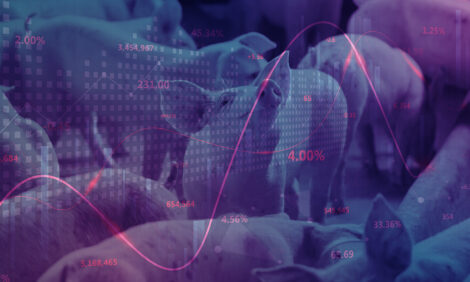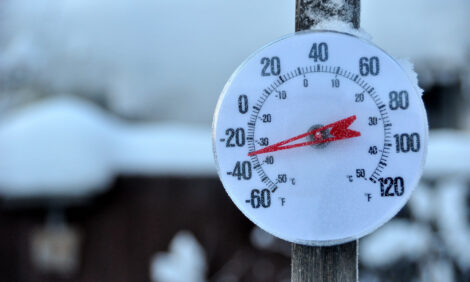



USDA Quarterly Pigs and Hogs Report: September 2004
This quarter's quarterly Hogs and Pigs report from the USDA's National Agricultural Statistics Service. The article provides the report text and graphs, and helps explain what it all means. Link also to the full PDF report.Introduction
This document aims to pull together, in one place of reference, all the various information generated by the USDA Quarterly report. This document includes:
USDA Quarterly report: September 2004What it all means
Graph data from the report Hog Inventories by State (external link - select State and navigate to file)
For a PRINTABLE VERSION of the full 24 page report in PDF format, including all the tabular data which is not shown in this article, Click Here
US Quarterly Pigs and Hogs Inventory: September 2004
U.S. inventory of all hogs and pigs on September 1, 2004 was 61.4 million head. This was 1 percent above both September 1, 2003, and June 1, 2004.
Breeding inventory, at 5.98 million head, was up 1 percent from September 1, 2003, and also up 1 percent from last quarter. Market hog inventory, at 55.4 million head, was 1 percent above last year and 2 percent above last quarter.
The June-August 2004 U.S. pig crop, at 26.0 million head, was up 1 percent from both 2003 and 2002. Sows farrowing during this period totaled 2.89 million head, 1 percent below last year. The sows farrowed during this quarter represented 49 percent of the breeding herd. The average pigs saved per litter was 9.00 for the June-August 2004 period, compared to 8.90 last year. Pigs saved per litter by size of operation ranged from 7.50 for operations with 1-99 hogs to 9.10 for operations with more than 5,000 hogs and pigs.
US Quarterly Pigs and Hogs Inventory: September 1

U.S. hog producers intend to have 2.86 million sows farrow during the September-November 2004 quarter, 1 percent above the actual farrows during the same period in both 2003 and 2002. Intended farrowings for December 2004-February 2005, at 2.85 million sows, are up 1 percent from the same period in 2004, and up 3 percent from the same period in 2003.
The total number of hogs under contract, owned by operations with over 5,000 head, but raised by contractees, accounted for 39 percent of the total U.S. hog inventory, up from 35 percent last year.
Revisions
All inventory and pig crop estimates for September 2003 through June 2004 were reviewed using final pig crop, official slaughter, death loss, and updated import and export data. Based on the findings of this review, small adjustments of less than one-half of one percent were made to September 2003 inventory components, December 2003 inventory components, September-November 2003 pig crop, and March 2004 inventory components. Adjustments of less than one percent were made to the December 2003-February 2004 pig crop and to the June 2004 inventory.
What it all means?
What the commentators and industry thinkers read into this data:
| Professor John Lawrence, Iowa State University Hog Inventories Turning the Corner Demand has carried the day in the 2004 pork market and will be needed if 2005 is to be a profitable year. The market ended September with four consecutive quarters with higher year over year prices at the same time there was an increase in supplies. This has happened in only two other quarters in the last 30 years. This year is on track to set a new record for US pork production, yet prices remain surprisingly strong headed into the fall. Supplies from US production and from Canada into the use are expected to remain large through the fall and into the year ahead. The U.S. inventory of all hogs and pigs on September 1, 2004, was 61.4 million head, 1% higher than the same time a year ago (Table 1). The breeding inventory was 5.98 million head, up 1% from 2003, and the market hog inventory, at 55.4 million head, was also 1% above last year. The inventory was slightly larger than the trade expected and may be initially considered bearish in the distant months. In particular, the breeding herd was larger than prereport estimates and will have its biggest impact in the second half of 2005. Continue reading this report here (PDF document) |
| Professor Mike Brumm, University of Nebraska September 2004 USDA Hogs and Pigs Report Commentary Many analysts have already commented on USDA upwards revisions to the June 1, 2004 inventory in Minnesota, Iowa and North Carolina. Of course, this upwards revision, plus the growth plans in the September 1 report are a reflection of the profitable state of today’s US pork industry. Unfortunately, Nebraska continues to decline in pig numbers relative to the US. Unfortunately, Nebraska continues to decline in pig numbers relative to the US. All pigs kept for market in Nebraska totaled 2.49 million, the same inventory as in the June 1 report. However, Nebraska’s share of the US kept for market inventory declined slightly to 4.49%, another low not seen in Nebraska since the 1960’s. Continue reading this report here |
| Ron Plain and Glenn Grimes Hogs and Pigs Report - September 2004 The September USDA Hogs and Pigs report came in more positive than our estimates, especially the market inventories for 60-179 lb. hogs. If the report is correct, hog marketings in the fourth quarter will be down about 1% on a daily basis compared to last year, but the total for the quarter will be down 2% due to one less weekday for slaughter in 2004 than last year. Because hog slaughter has run about 2% above the USDA Hogs and Pigs estimate for most of the year, we believe that commercial slaughter in the fourth quarter will run about 28 million head or about 1% above last year. Continue reading this report here |
| Chris Hurt, Purdue University Chris Hurt Hog producers will do their part in expanding usage of this fall's large crops, said a Purdue University Extension marketing specialist. The impact may not be seen until next spring and summer and the full force won't be felt for another year, says Chris Hurt in his review of the Quarterly Hogs and Pigs report. Last spring, high grain prices were telling end users they needed to 'hit the brakes' on usage," said Hurt. "Now low grain prices are telling end-users to 'stomp on the accelerator.' What is the reaction time to move from slow-down to speed-up? The answer, of course, depends on the sector." Continue reading this report here |
Graph Data from the Report
US Quarterly Litter Rate: June - August

US Pigs Per Litter
By Size of Operation: June - August 2004

US Quarterly Sows Farrowed
June - August

US Quarterly Pig Crop: June - August

March 1 Hog Inventory and Market Hogs (US)

June 1 Hog Inventory and Market Hogs (US)

September 1 Hog Inventory and Market Hogs (US)

December 1 Hog Inventory and Market Hogs (US)

Reliability of September 1 Hogs and Pigs Estimates
Survey Procedures: A random sample of roughly 11,700 U.S. producers was surveyed to provide data for these estimates. Survey procedures ensured that all hog and pig producers, regardless of size, had a chance to be included in the survey. Large producers were sampled more heavily than small operations. Data were collected from about 9,650 operations, 83 percent of the total sample, during the first-half of September by mail, telephone, and face-to-face personal interviews. Regardless of when operations responded, they were asked to report inventories as of September 1.
Estimation Procedures: These hogs and pigs estimates were prepared by the Agricultural Statistics Board after reviewing recommendations and analysis submitted by each State office. National and State survey data were reviewed for reasonableness with each other and with estimates from past years using a balance sheet. The balance sheet begins with the previous inventory estimate, adds the estimates of births and imports, and subtracts the estimates of slaughter, exports, and deaths. This indicated ending inventory level is compared to the Agricultural Statistics Board estimate for reasonableness.
Revision Policy: Revisions to previous estimates are made to improve quarter to quarter relationships. Estimates for the previous four quarters are subject to revision when current estimates are made. In December, estimates for all quarters of the current and previous year are reviewed. The reviews are primarily based on hog check-off receipts and slaughter. Estimates will also be reviewed after data from the Department of Agriculture five-year Census of Agriculture are available. No revisions will be made after that date.
Reliability: Since all operations raising hogs are not included in the sample, survey estimates are subject to sampling variability. Survey results are also subject to non-sampling errors such as omissions, duplication, and mistakes in reporting, recording, and processing the data. The affects of these errors cannot be measured directly. They are minimized through rigid quality controls in the data collection process and through a careful review of all reported data for consistency and reasonableness.
To assist users in evaluating the reliability of the estimates in this report, the "Root Mean Square Error" is shown for selected items in the following table. The "Root Mean Square Error" is a statistical measure based on past performance and is computed using the difference between first and final estimates. The "Root Mean Square Error" for hog inventory estimates over the past 20 quarters is 1.1 percent. This means that chances are 2 out of 3 that the final estimate will not be above or below the current estimate of 61.4 million head by more than 1.1 percent. Chances are 9 out of 10 that the difference will not exceed 1.9 percent.






